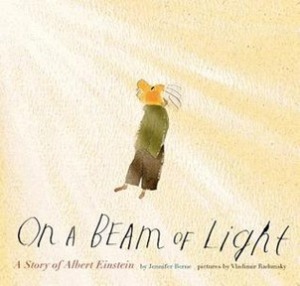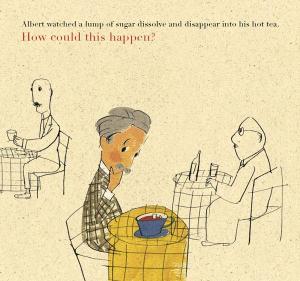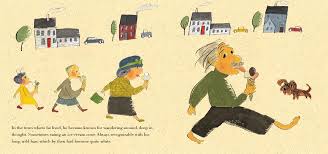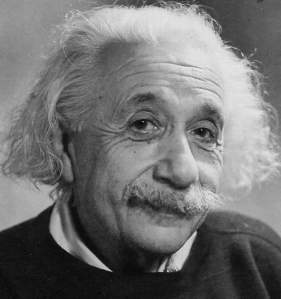 On a Beam of Light: A Story of Albert Einstein, by Jennifer Berne, pictures by Vladimir Radunsky
On a Beam of Light: A Story of Albert Einstein, by Jennifer Berne, pictures by Vladimir Radunsky
When I first noted that a new picture book about Albert Einstein was out, I admit, I was skeptical. Albert Einstein in a picture book? The theory of relativity for 5 year olds? Isn’t that reaching a bit far?
I am pleased to say that I was utterly wrong about this one. It’s brilliant.
Jennifer Berne’s introduction of Einstein, the person, is fascinating and light-handed at the same time. Einstein’s personhood is front and center — his slowness to speak as a young child, his playful eccentricities as a grown up, and always, always his wonderings and imagination. For Einstein was, above all things, a question-asker, a guy who said, “I wonder why?” and “I wonder how” perhaps more than anyone else. Who took his sailboat out in order to be alone with just the breeze and the open water and his thoughts. Marvelous.
at the same time. Einstein’s personhood is front and center — his slowness to speak as a young child, his playful eccentricities as a grown up, and always, always his wonderings and imagination. For Einstein was, above all things, a question-asker, a guy who said, “I wonder why?” and “I wonder how” perhaps more than anyone else. Who took his sailboat out in order to be alone with just the breeze and the open water and his thoughts. Marvelous.
Berne also touches on some of Einstein’s scientific ideas including atoms, motion, and the speed of light. Her adeptness at lucidly introducing these ideas without talking down nor bogging down is astonishing. The simple, clear sentences that remain here must be the work of a tremendous amount of thinking and paring and devising on her part. An Author’s Note allows her to speak just a bit more in-depth about some Einstein details she didn’t want us to miss, geared for mid-elementary and older.
 Vladimir Radunsky’s loose pen and ink and gouache artwork adds to the friendliness of this book. Sketchy, flowing lines, a quirky, childlike quality to his shapes, warm swashes of color, all on a homemade textured paper, communicate the messyness of creativity, the unconventionalness of Einstein, the humanness of this subject rather than the intimidating,stuffy, intellectual feel it might have, and make the book supremely accessible to early-elementary children.
Vladimir Radunsky’s loose pen and ink and gouache artwork adds to the friendliness of this book. Sketchy, flowing lines, a quirky, childlike quality to his shapes, warm swashes of color, all on a homemade textured paper, communicate the messyness of creativity, the unconventionalness of Einstein, the humanness of this subject rather than the intimidating,stuffy, intellectual feel it might have, and make the book supremely accessible to early-elementary children.
You know by now that I am a strong advocate of non-electronic pastimes for children –for quieter lives and unstructured time and outdoor play and individuality — so this book warmed the cockles of my heart with its strong call for “wondering, thinking, and  imagining.” Further evidence that the secret to developing significant scientific achievers is not to cram more and more facts into younger and younger children, but to give our children time, space, and freedom to be alone with their thoughts, to wonder, imagine, and ask qustions.
imagining.” Further evidence that the secret to developing significant scientific achievers is not to cram more and more facts into younger and younger children, but to give our children time, space, and freedom to be alone with their thoughts, to wonder, imagine, and ask qustions.
New in 2013. Check this one out for anyone age 5 and up.
Can’t wait to read this one. You’ve inspired me to ask again: “I wonder if this is at my local library yet?” 🙂
Yes, that’s a question I ask a lot 🙂
Our library had it! And we all loved it.
Yay! Glad you loved it :)I loved the fact that he wondered about sugar lumps dissolving. I don’t think to wonder about so many things.